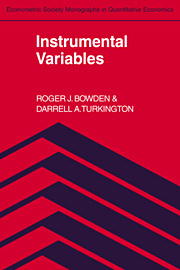5 - Nonlinear estimation with instrumental variables
Published online by Cambridge University Press: 05 January 2013
Summary
Introduction
The burgeoning of interest in nonlinear equations and models that has occurred in the last decade or so has been largely contemporaneous with the enhancement of computing power and the availability of convenient and effective algorithms for numerical optimization. Thus whereas students in the fifties and early sixties were preoccupied with linear models or their direct generalizations, the seventies saw the establishment of a better understanding of the estimation theory for nonlinear models. In particular, it was realized that instrumental variables methods could, by the definition of an appropriate minimand, be regarded as a minimization problem and the resulting estimators regarded as fairly natural generalizations of the linear theory, with respect to both limited- and full-information systems. At the same time it became clear that there were limits to this process of generalization - that certain efficiency properties, for instance, did not carry over to the nonlinear context.
In setting out to describe these developments, the first task is to establish some kind of taxonomy of the types of models encountered. One may distinguish between models that are nonlinear only in their parameters, or only in their variables, and models that are nonlinear both in their equations and in their variables. The relevant models are set out, with examples, in Section 5.2. In this section we use the relatively simple context of linear-in-parameter models to establish certain generic kinds of instrument.
- Type
- Chapter
- Information
- Instrumental Variables , pp. 156 - 201Publisher: Cambridge University PressPrint publication year: 1985
- 3
- Cited by



